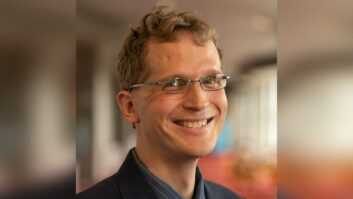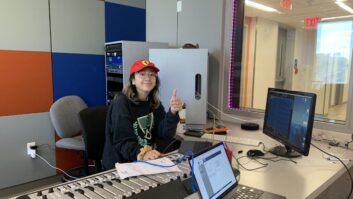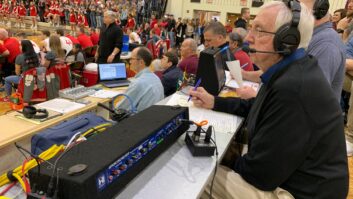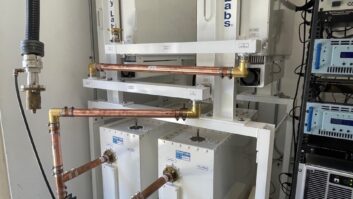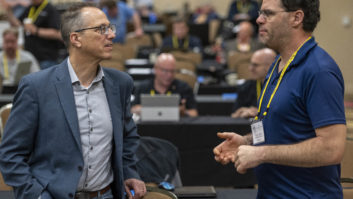• Tuesday morning April 17
“Radio Facilities”• Tuesday afternoon April 17
“Broadcast Facility Safety and Compliance”• Tuesday afternoon April 17
“Technical Planning for Emergencies”by Conrad Trautmann
One in a series of day-by-day descriptions of events at the upcoming Broadcast Engineering Conference of NAB2007.
RADIO FACILITIES
The Tuesday morning session is chaired by Paul Shulins, director of technical operations for Greater Media’s Boston radio stations.
“‘Radio facilities’ is a somewhat generic term that doesn’t do justice to the exciting lineup we have in store,” he said.
“Rebuilding a Legend: Considerations in Rebuilding WOR Radio From the Tip of the Mic to the Top of the Tower” will be presented by Tom Ray, vice president and corporate director of engineering for Buckley Broadcasting and an RW contributor.
Ray has been living on the bleeding edge of technology for the past few years and will share his experiences. WOR was the first AM station in New York City to implement HD Radio; the station also was the first in the market to install an IP-based audio routing system at the new studios it built blocks from Ground Zero.
If that wasn’t enough excitement, Ray also had to move the WOR AM directional array in northern New Jersey to a new site.
“We’ll have many construction pictures, tips on things to watch out for, ‘contractor follies’ and why we made some of the choices we did,” he said. Ray will finish his discussion with video of the collapse of the old WOR Lyndhurst towers, 681 feet in height and over 85,000 pounds in weight.
“Working With the Free Software Community to Replace a Radio Broadcast Automation System” — Frederico Grau, the systems administrator for Radio Free Asia, will discuss how radio stations on a limited budget can use free and open source software to reduce capital and operating expenses.
Grau, a software developer himself, has been working with the free software community to help develop automation solutions for RFA. He’ll address concerns regarding reliability of the operating systems and support.
Mario Hieb, P.E., will present “Systems Integration Techniques for Radio Engineers.” This session will cover all aspects of a large project including design, budgeting, planning, construction and project management. Hieb takes television systems integration techniques and shows how they can be applied to radio projects. If you’re facing a studio or transmitter move, this would be a good guide on how to approach the project. Like Tom Ray, he is an RW contributor.
“An Embedded Systems Approach to IP-Based Broadcast Facility Remote Control” — Stephen Dinkel, director of North American sales for Burk Technology, will demonstrate how new technology can be used to enhance your remote site monitoring.
He’ll also describe how using this technology can improve alarm notification, share that data more efficiently and shorten response times to problems. This could benefit multi-station clusters, contract engineers who are on call for many stations and larger companies that have central monitoring points.
Stephen Lampen of Belden Cable, also a Radio World contributor, will remind you of the “100 Things You Forgot” about audio and video wire, cable and connectors.
Lampen is an entertaining presenter and takes what might not sound terribly exciting and puts a fun, educational spin on it. He holds an FCC Lifetime General license and has had an extensive career in radio broadcast engineering and installations. He knows from experience what’s important to the radio broadcast engineer.
In addition, with new IP-audio systems and high-speed data flowing around your facility, it’s a good idea to see the latest developments in the technology behind the wire and connectors that keep your station running reliably.
“Packets Everywhere: How IP Audio and Ethernet Are Transforming Modern Radio Facilities” by Martin Sacks will explore the latest advancements in IP audio and how you can apply it to your station.
Sacks, of Axia Audio, shows the advantages of IP audio, including machine control, transmission of program associated metadata (which is a must for HD Radio) and audio routing.
“We are constantly amazed by the many uses our clients find for IP audio,” he said. “From soundcard replacement to STL systems, IP audio is found in many parts of a modern broadcast plant.”
BROADCAST FACILITY SAFETY AND COMPLIANCE
A one-hour session on safety and compliance will be held Tuesday in the early afternoon.
It is chaired by John Lyons, assistant vice president and director of broadcast and communications for the Durst Organization.
Lyons, Radio World’s “Excellence in Engineering” award recipient in 2006, is intimately familiar with the topic at hand. He developed his own RF safety system for the roof of 4 Times Square, the newest rooftop broadcasting facility in the heart of New York. If you’re involved in any way with a city skyscraper transmission facility, Lyons is someone you should meet.
“What Broadcast Tower Owners and Tenants Need to Know about 222-G” will cover the 10 most important developments of this new tower standard. You will want to attend if you have plans to add, modify or change anything on your station’s tower, or if you need to install a new tower.
Thomas Hoenninger, vice president of operations and chief engineer of Stainless LLC, will explain how the code change treats things like design requirements and how transmission line load calculations will be figured differently. He’ll point out that the materials from which towers are constructed have changed in the code. Changes also affect foundations because soil calculations are evolving. If you own, operate or rent space on towers, this is material you must know.
Hoenninger has case studies to illustrate things to look for between the current code and the new one. He’ll also explain how to get your own copy of the new standard.
Matt Bruskotter of the University of Findlay in Ohio is presenting “ENG and All-Hazards Safety.” When the term “first responders” is used, those who come to mind are fire, police and emergency health workers. But ENG crews also are first responders, usually on the scene at the same time as these emergency professionals during a disaster or major news event. Bruskotter will detail the training that ENG crews should have and point out things the ENG first responders should be aware of.
TECHNICAL PLANNING FOR EMERGENCIES
Martin Hadfield, vice president of engineering for Entercom Communications Corp., will chair the second afternoon session, which follows the one above. EAS, backup power, disaster recovery and alternate transmission methods are topics.
He said speakers will address lessons learned during and after the Katrina and Rita hurricanes.
“The solutions offered in these presentations have already found uses far beyond the devastated Gulf Coast region and should provide some pearls of wisdom which would be applicable to any size of radio and TV broadcast facility,” he said.
Geoff Freed, project manager for the WGBH National Center for Accessible Media, will be the presenter for “Access to Emergency and Non-Emergency Information for People With Disabilities.”
NCAM is dedicated to equal access to media and information for everyone; it is involved in technology, policy and program development to assure that media and technologies are accessible. Freed will describe how the organization is exploring solutions that will allow people with visual or hearing impairments to receive warnings and alerts from local television stations.
Duncan Ayre, manager of media monitoring for Canada’s Department of National Defense, will talk about how that organization works with reporters to collect, distribute and archive electronic information in “Media Monitoring by the Military in the Electronic Age.”
Ayre is responsible for gathering media clips from local, national and international sources that are used to keep Canadian defense officials informed of situations around the world.
“Wireless Wideband Services Save the Day for a Mount Hood Transmitter Facility” is the story of how KPFR(FM) applied the use of cellular telephone wideband technology as a method to control and monitor a remote tower site.
James Dalke, a consulting engineer, will explain how conventional remote control methods were virtually impossible to use at this remote tower site. He will also give a live demonstration of the system and show how it was designed.
Bruce Robertson of Digital Alert Systems is the presenter of “Improve EAS by Adding Details to the Messages.”
“In this discussion a method will be presented that demonstrates how to improve EAS by adding details to the entire message,” he said. The process will show how the message can contain URLs that offer access to Web sites, making EAS IP-compatible. “This method does not change the protocol, does not violate the ruling, does not obsolete current equipment, and can be incrementally implemented where it will be most effective.”
Robertson says implementation of this method by emergency operations centers will allow broadcasters to strongly consider participation.
Mark O’Brien, executive vice president of SpectraRep and 20-year veteran of the broadcasting industry, is going to speak about “Police Communications and DTV, Pushing Critical Data to the Field.”
He plans a live demonstration showing how it’s possible to use excess capacity in a digital television signal to get critical information to police squad cars.
“MTV Networks’ Disaster Recovery Facility — Case Study” will focus on disaster recovery plans that the big media entity has in place for its main uplink facility in Long Island, N.Y.
Lionel Hightower, vice president of engineering of Viacom/MTV Networks, will present and give details about its backup systems and disaster recovery plans.
Winding up the day’s emergency planning sessions is Gary Rackow, vice president of sales for Active Power, with a session called “Top Story: Broadcasters Discover Flywheel Technology as New Solution for Reliable, Continuous Backup Power.”
Clearly, emergency power is critical to any broadcast facility. If you’re tired of replacing batteries in your UPS, DC flywheel technology is an alternative. Used in conjunction with a standby generator, he says, flywheel technology is an environmentally safe and reliable method to provide uninterrupted power. Rackow will describe how broadcasters are putting the technology to use.
Conrad Trautmann is senior vice president of engineering & technology at Westwood One Inc.
Tuesday’s Engineering Sessions: Facilities That Work, Safely
One in a series of day-by-day descriptions of events at the upcoming Broadcast Engineering Conference of NAB2007.





